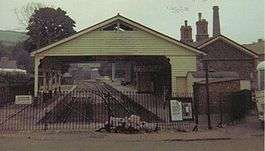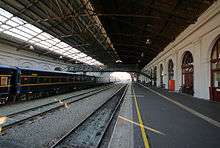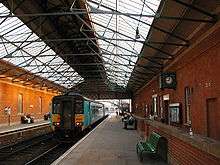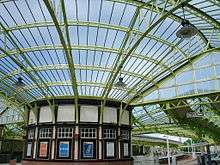Train shed
A train shed is a building adjacent to a station building where the tracks and platforms of a railway station are covered by a roof. It is also known as an overall roof. The first train shed was built in 1830 at Liverpool's Crown Street Station.
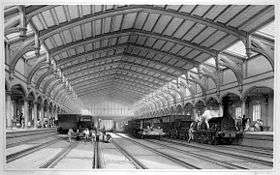
The biggest train sheds were often built as an arch of glass and iron, while the smaller were built as normal pitched roofs.
The train shed with the biggest single span ever built was that at the second Philadelphia Broad Street Station, built in 1891.
Types of train shed
Early wooden train sheds
The earliest train sheds were wooden structures, often with unglazed openings to allow smoke and steam to escape. The oldest part of Bristol Temple Meads is a particularly fine – and large – example, designed by Isambard Kingdom Brunel with mock-hammerbeam roof.
Surviving examples include:
Classic metal and glass
The middle of the nineteenth century saw many large stations covered by iron, steel and glass train sheds, inspired by The Crystal Palace at The Great Exhibition in 1851. The best have been described as "like cathedrals" and feature curved roofs; other structures have pitched roofs.
Surviving examples of curved roof train sheds include:
- Amsterdam Centraal, Netherlands
- Antwerpen-Centraal, Belgium
- Bath Green Park railway station, England (converted to covered market and car park)
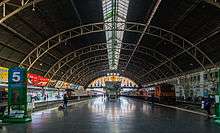 Bangkok
Bangkok - Bangkok, Thailand
- Barcelona Estació de França, Catalonia, Spain
- Brighton, England
- Bristol Temple Meads, England
- Copenhagen Central Station, Denmark
- Darlington Bank Top, England
- Frankfurt (Main) Hauptbahnhof, Germany
- Glasgow Queen Street, Scotland
- Hull Paragon, England
- Gare de Lille Flandres, France
- Köln Hauptbahnhof, Germany
- Liverpool Lime Street, England
- London Kings Cross, England
- London Paddington, England
- London St Pancras, England
- Madrid Atocha, Spain (converted to station atrium)
- Manchester Central, England (converted to conference centre)
- Manchester Piccadilly, England
- Milano Centrale, Italy
- Newcastle Central, England
- Prague Main Station, Czech Republic
- Reading Terminal, Philadelphia, United States (converted to convention center)
- Tanjung Priok, Jakarta, Indonesia
- York, North Yorkshire, England
- Vitebsky railway station, Saint Petersburg, Russia
- Lviv Railway station, Ukraine
Surviving examples of pitched roof train sheds include:
- Ballarat, Geelong (and No 2 Goods Shed Melbourne), Australia
- Beverley, England
- Bournemouth, England
- Budapest Nyugati, Hungary
- Budapest Keleti, Hungary
- Carlisle Citadel, England
- Chester, England
- Crewe, England
- Edinburgh Waverley, Scotland
- Frome, England
- Filey, England
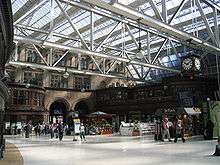
- Glasgow Central station, Scotland
- Harrisburg Transportation Center, Harrisburg, Pennsylvania, United States
- Kuala Lumpur, Malaysia
- London Liverpool Street, England
- Paris Gare du Nord, France
- Paris Gare de Lyon, France
- Preston, England
- Stoke-on-Trent, England
- Wemyss Bay, Scotland
Surviving examples of Bush-type, developed by American civil engineer Lincoln Bush, and related train sheds include:
- Hoboken Terminal, Hoboken, New Jersey, United States
- Union Station, Winnipeg, Manitoba, Canada
- Toronto Union Station, Toronto, Ontario, Canada - designed by A.R. Ketterson
- Communipaw Terminal, Jersey City, New Jersey, United States
- Mount Royal Station used by Maryland Institute College of Art for its Sculpture program Baltimore, Maryland
Surviving examples of other train sheds include:
- Pennsylvania Station (Newark), Newark, New Jersey, United States
- The SEPTA platform area of 30th Street Station, Philadelphia, United States
Concrete
The middle of the twentieth century saw concrete used as a structural material.
Surviving examples include:
- Cockfosters tube station, London, England
- Uxbridge tube station, London, England
- Volksdorf U-Bahn station, Hamburg, Germany
Modern steel and glass
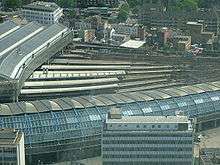
After many years with few, if any, significant new train sheds, recent years have seen some major stations given graceful train sheds by using modern technology.
Examples include:
- Berlin Hauptbahnhof, Berlin, Germany
- Longyang Road station on the Shanghai Maglev Train line
- Gwangmyeong Station, Seoul, South Korea
- Jefferson Station, Philadelphia, United States (while station is located underground, it has above-ground structures for the purpose of sheltering the platforms and trains)
- Stillwell Avenue subway station, New York City, United States
- Waterloo International, London, England
- Southern Cross station, Melbourne, Australia
- Liège-Guillemins, Liège, Belgium
- Manchester Victoria station, Manchester, England
In the United States, the Walt Disney World Monorail System has some trainsheds along its route, including the entrance-gate station and the main hall (or Grand Canyon Concourse) of the Contemporary Resort.
Open-air canopy
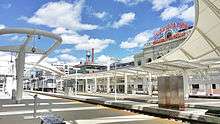
Car barn
In North America tram cars, there called streetcars or trolleys, are sometimes stored in structures called car barns or car houses. These buildings are usually enclosed and provide cover for trams from the elements.
List of car barns:
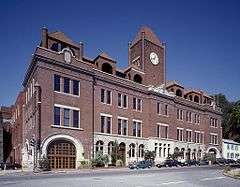
- Roncesvalles Carhouse - Toronto
- Leslie Barns - Toronto
- Russell Carhouse (Connaught Barns) - Toronto
- Wychwood Barns - Toronto
- Eglinton Maintenance and Storage Facility (Black Creek Carhouse) - Toronto
- Watertown Yard - Watertown, Massachusetts
- North Cambridge Carhouse - Cambridge, Massachusetts
- Plaistow Carhouse - Plaistow, New Hampshire
- Ashby Street Car Barn - Atlanta, Georgia
- Luzerne Carhouse - Philadelphia
References
- ProjectWest. "What's New?". www.rtd-fastracks.com. Retrieved 18 April 2018.
| Wikimedia Commons has media related to Train sheds. |
